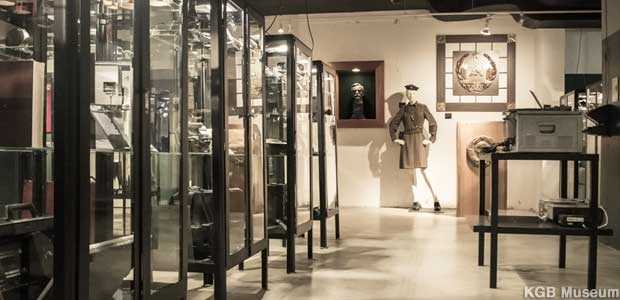
Soviet glamour mannequin, framed bust of "Iron Felix" Dzerzhinsky, and spy gadgets in the KGB Museum.
KGB Espionage Museum (Closed)
New York, New York
"What you see is not always what it is," said Agne Urbaityte, the Lithuanian curator of the KGB Espionage Museum. She was talking about the everyday items on display -- handbags, dishes, fountain pens -- that were in fact cameras, microphones, and assassination weapons.
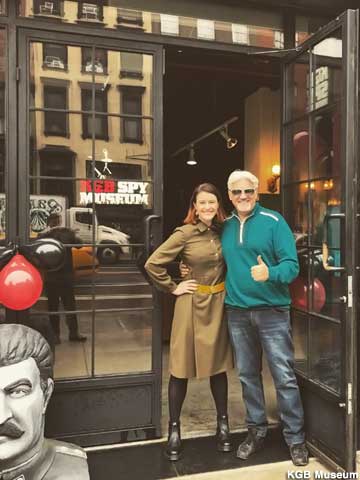
Curators Agne Urbaityte and Julius Urbaitis.
The same observation could be made about the museum itself, which opened in January 2019 in New York City, and was initially thought by some sophisticated locals to be a political stunt or a glorified gift shop. "I tell them, 'No, it's not a joke,'" said Agne. "'It's a real museum.'"
The museum's collection of over 3,700 espionage artifacts was brought to America by Agne and her father Julius Urbaitis, who'd been amassing Soviet spy memorabilia for 30 years. Agne said that some of the items came to her father via "human mistakes" (theft), and some were openly sold by former workers from the vast Soviet espionage network, which at one point employed a half-million people.
Many of the relics, Agne said, are still technically secret, which is why displaying them in Russia would probably not be a good idea.
The KGB was more than just a spy agency: it frequently served as the Soviet Union's jailer, torturer, and political executioner. It was, said Agne, responsible for "a lot of bad things."
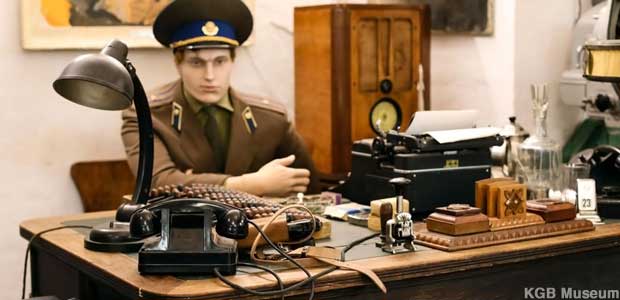
KGB officer-dummy ready for the interrogation. Console radio in the background belonged to Stalin.
The museum space has a blackened ceiling and cement walls and floors, with the sunless vibe of a Siberian gulag. Showcases display a smorgasbord of Soviet spy gear, while the perimeter is lined with propaganda posters and interactive exhibits.
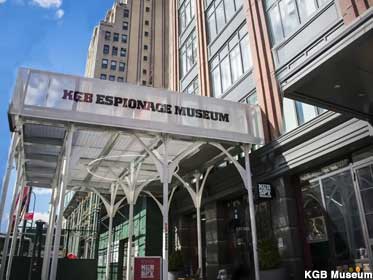
Yes, it's a real museum.
Visitors can don a trench coat and pose for photos at a KGB officer's desk, or peer through slots in grim Soviet-bloc prison doors to watch videos of doomed actor-convicts. A special chair, previously employed in the interrogation of half-mad inmates at a KGB insane asylum, is available for those who care to sit.
"We can tie people down," said Agne of the chair's leather straps. "Some visitors want to feel it. Different people learn in different ways."
The museum claims to possess the largest collection of KGB gizmos ever assembled for public viewing, and provides a uniquely capitalist -- i.e., for an admission fee -- view of communist spycraft. All of the artifacts are original except for replicas of two gadgets that were were impossible to collect, but too important not to have in a Soviet spy museum: the umbrella of death, tipped with a mechanical hypodermic poison spike, that killed a Soviet defector in 1978; and "The Thing," a hand-carved wooden version of the Great Seal of the U.S., presented to America's ambassador in Moscow by Russian boy scouts. It hung in the ambassador's office for nine years -- an unfortunate perch of honor, since it was later found to contain a super-sophisticated bug with a tiny microphone in the bald eagle's beak.
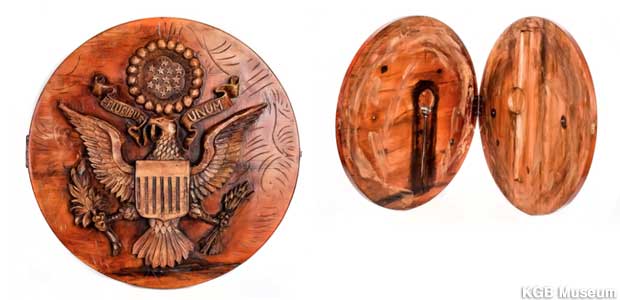
Soviet bug, hidden inside the Great Seal of the U.S., was hung in America's Moscow embassy.
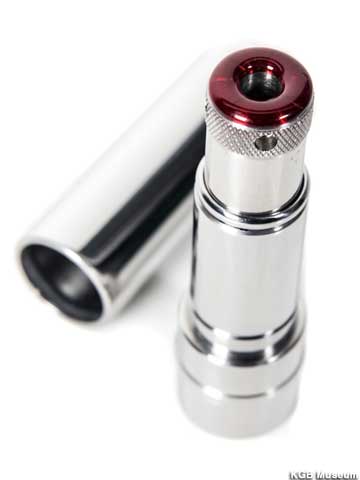
"Deadly Kiss" lipstick gun was designed for assassinations.
Vintage examples of Soviet spyware on display include miniature cameras hidden in books, cigarette packs, a belt buckle, a shoe brush, a 1980s boom box, and a not-very-subtle oversized ring. There are shoes with secret compartments; microphones embedded in watches and ashtrays; a "tree with eyes and ears;" sophisticated mechanical cipher machines; and cheap-looking bald head wigs. A fake tooth containing cyanide enabled captured spies to make quick, final exits.
One of the museum's star artifacts is "Deadly Kiss," a gun disguised as a tube of lipstick. We asked Agne if it had ever been used. "I cannot tell you this," she said. "We do not have that information" -- although the tone of her voice suggested that they had some suspicions.
Agne agreed that a tour of the KGB Espionage Museum might increase a visitor's paranoia, but her personal outlook was surprisingly sunny: the smartphone in your pocket, she said, gives you snooping abilities far beyond anything that the KGB could have imagined. Everyone can be a spy nowadays, which makes it less threatening, kind of.
New York City is home to thousands of ex-Soviet-bloc citizens, so we asked Agne if she thought that the museum had been visited by former KGB agents. "Of course," she said. "But they are not telling. I think not many of them want to say 'Hi.'"




